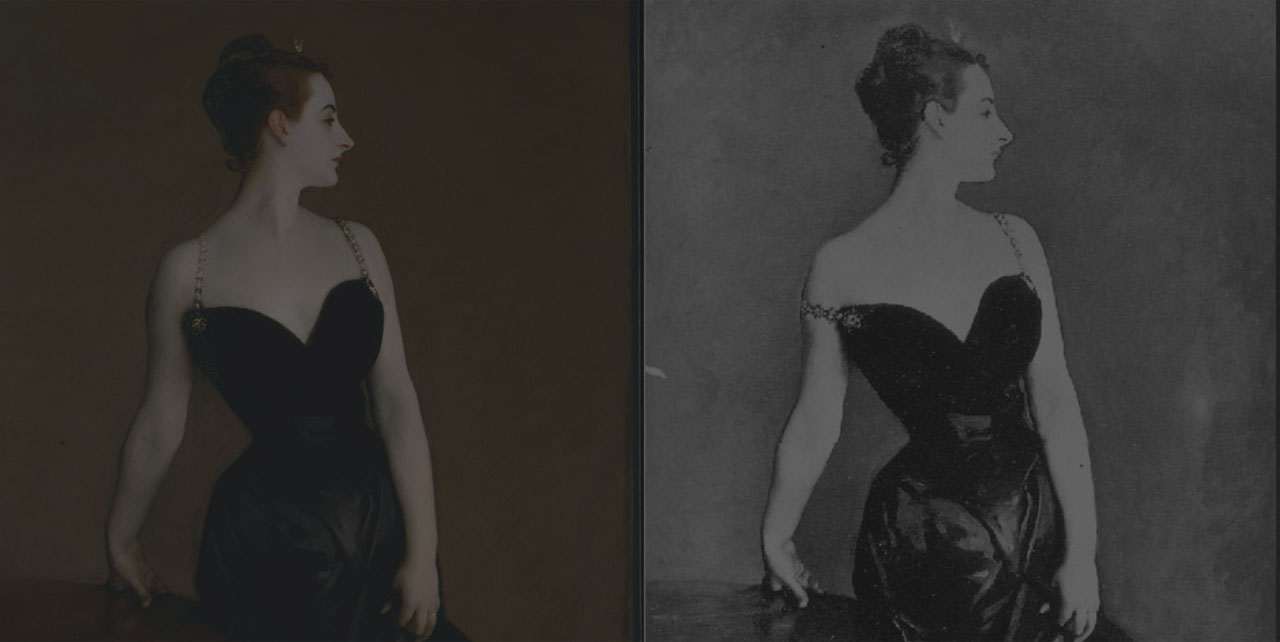The Project
Paintings Uncovered is an interactive interface for the Metropolitan Museum of Art exploring hidden layers underneath paintings.
Showcase:Metropolitan Museum of Art Digital Media Lab Expo
Date:2014
Role:Designer, Developer
Skills:OpenFrameworks
Painters frequently paint over paintings for various reasons — sometimes with a completely different subject. Art historians can examine the underlying surfaces through reflectography —an infrared technique to detect layers beneath the top surface of a painting— providing them with valuable information about the artwork.
These underlying layers reveal fascinating stories about intent and process that are not obviously evident when visitors see the paintings. So I wondered:
How can museums incorporate interactive installations to teach visitors about the hidden history of artworks?
To explore this concept, I chose to work one of my favorite paintings at the Metropolitan Museum of Art: The Portrait of Madame X by John Singer Sargent.

Left: The portrait as it appears currently in the museum. Right: The original portrait, revealed through infrared scans.
History of the Portrait of Madame X
The Portrait of Madame X shows a woman, Virginie Amélie Avegno Gautreau, posing in a black dress, her pale skin a striking contrast against the dark garment and background.
This portrait was the subject of controversy when it was unveiled at the Paris Salon in 1884. In the original painting, the strap on Gautreau’s right shoulder rested seductively off her shoulder — viewers were shocked, causing a scandal that resulted in the mockery of both Sargent and Gautreau. Critics also ridiculed the color of her skin and pose. Sargent, who had painted Gautreau as she was originally dressed, painted over the original strap so that it was securely on her shoulder.In 1916, he sold the painting to the Metropolitan Museum of Art.
This is one of my favorite backstories about a painting at the Met, one that viewers would not know by simply looking at the painting in its current form. I wanted to experiment with sharing the story in an interactive way, so I created an interface that reacted to infrared light to reveal the original painting that lies underneath.
Project Goals
I had two goals in mind with the project:
It was important to me to engage users with critical thinking rather than lecturing them about the painting's story. Instead, I wanted to encourage viewers to experience personal, meaningful observation with the work through inquiry.
This approach to museum education came from my experience as a docent for The Fralin Museum of Art. As a docent, I was trained to teach people how to look at and think about art by posing questions to the visitors instead of immediately jumping into a lecture. I continued that methodology in this project by creating an inquiry-based experience that encourages viewers to examine the painting more closely.
In addition, I wanted to move away from traditional museum labels and experiment with other ways of displaying information. I was inspired by my childhood dream of becoming a paleontologist. As a child, I was always excited when I could "role play" as a paleontologist at natural history museums. In this project, I aimed to bring back that feeling of role playing.
The Installation
In Paintings Uncovered, users point an infrared flashlight at a digital display of the Portrait of Madame X. An infrared camera tracks the position of the light to create a circular mask on corresponding areas of the painting. This creates the illusion of "burning through" the top layer, revealing the underlying surfaces that Sargent deliberately covered. Moving the flashlight onto certain areas triggers specific questions about the work, making it primarily an inquiry-based exploration. Some questions I posed were:
I built this installation by using openFrameworks (a C++ toolkit for creative coding) and the PS3 Eye, a small, portable camera for the PlayStation 3. I modified the PS3 Eye by removing the infrared filter and installing a visible light filter instead. I then took apart a flashlight I purchased at the dollar store (the cheaper the flashlight, the easier it is to take apart) and switched its LED with an infrared LED. The camera is then hidden underneath or above the digital display.
The Portrait of Madame X is nearly eight-feet tall, and in an ideal scenario, the digital version of the painting would be projected or displayed at the same size as the original. By prompting the visitor to move their arms in order to examine the painting, the interaction emphasizes the portrait's striking size.
Conclusion
This project was built over the course of two months and culminated with a presentation and demonstration to staff and visitors at the Met.
Originally, the project was created with the intent to enhance tours, although further improvements could include creating an interaction where visitors can find answers without a tour guide. The project challenged me think about how technology could be used to tell the stories behind the artworks in museums and move away from traditional labels and brochures. After all, learning about the history and intent of the artworks truly enhances the museum experience and makes art memorable.


